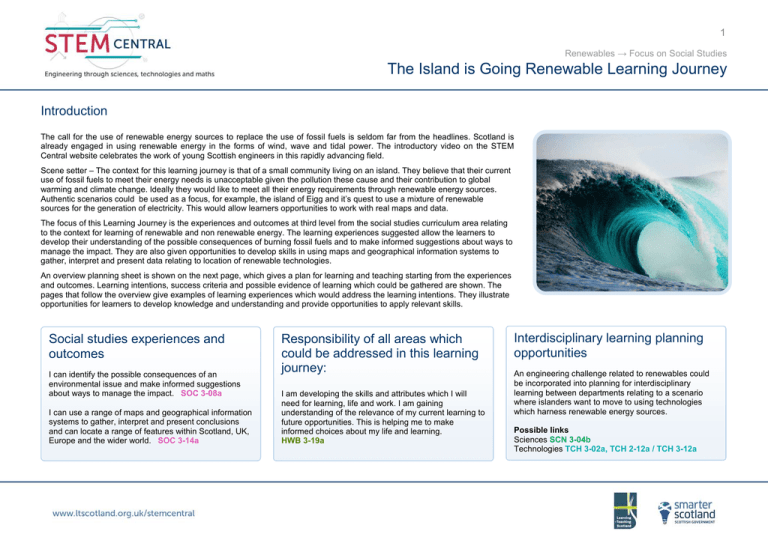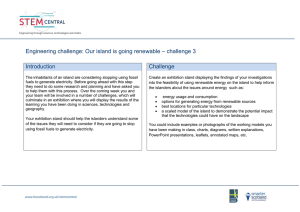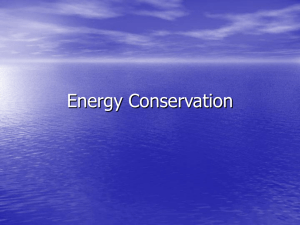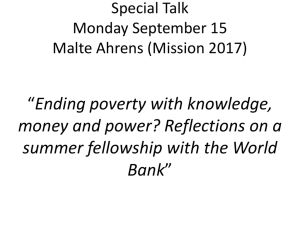The Island is Going Renewable Learning Journey Introduction v
advertisement

1 Renewables → Focus on Social Studies The Island is Going Renewable Learning Journey Introduction The call v for the use of renewable energy sources to replace the use of fossil fuels is seldom far from the headlines. Scotland is already engaged in using renewable energy in the forms of wind, wave and tidal power. The introductory video on the STEM Central website celebrates the work of young Scottish engineers in this rapidly advancing field. Scene setter – The context for this learning journey is that of a small community living on an island. They believe that their current use of fossil fuels to meet their energy needs is unacceptable given the pollution these cause and their contribution to global warming and climate change. Ideally they would like to meet all their energy requirements through renewable energy sources. Authentic scenarios could be used as a focus, for example, the island of Eigg and it’s quest to use a mixture of renewable sources for the generation of electricity. This would allow learners opportunities to work with real maps and data. The focus of this Learning Journey is the experiences and outcomes at third level from the social studies curriculum area relating to the context for learning of renewable and non renewable energy. The learning experiences suggested allow the learners to develop their understanding of the possible consequences of burning fossil fuels and to make informed suggestions about ways to manage the impact. They are also given opportunities to develop skills in using maps and geographical information systems to gather, interpret and present data relating to location of renewable technologies. An overview planning sheet is shown on the next page, which gives a plan for learning and teaching starting from the experiences and outcomes. Learning intentions, success criteria and possible evidence of learning which could be gathered are shown. The pages that follow the overview give examples of learning experiences which would address the learning intentions. They illustrate opportunities for learners to develop knowledge and understanding and provide opportunities to apply relevant skills. Social studies experiences and outcomes I can identify the possible consequences of an environmental issue and make informed suggestions about ways to manage the impact. SOC 3-08a I can use a range of maps and geographical information systems to gather, interpret and present conclusions and can locate a range of features within Scotland, UK, Europe and the wider world. SOC 3-14a Responsibility of all areas which could be addressed in this learning journey: I am developing the skills and attributes which I will need for learning, life and work. I am gaining understanding of the relevance of my current learning to future opportunities. This is helping me to make informed choices about my life and learning. HWB 3-19a Interdisciplinary learning planning opportunities An engineering challenge related to renewables could be incorporated into planning for interdisciplinary learning between departments relating to a scenario where islanders want to move to using technologies which harness renewable energy sources. Possible links Sciences SCN 3-04b Technologies TCH 3-02a, TCH 2-12a / TCH 3-12a 2 Renewables → Focus on Social Studies The Island is Going Renewable Learning Journey Experiences and outcomes I can identify the possible consequences of an environmental issue and make informed suggestions about ways to manage the impact. Learning intentions Success criteria Possible evidence Understand the impact of continued use of fossil fuels to generate electricity and make informed suggestions about ways to manage the impact I can discuss and research possible consequences of burning fossil fuels Short written, oral or visual explanation of a problem associated with burning fossil fuels, possible consequences and possible solutions Apply knowledge of reading maps to match possible methods of energy generation with suitable locations I can use contour maps and data to suggest possible locations for wind or wave, renewable technologies Understand the geographical factors which need to be taken into account when planning for renewable engineering energy projects I can give examples of which geographical factors will need to be considered for the installation and effective use of a particular renewable technology I can suggest and assess solutions which might help to manage the impact of burning fossil fuels SOC 3-08a I can use a range of maps and geographical information systems to gather, interpret and present conclusions and can locate a range of features within Scotland, UK, Europe and the wider world. SOC 3-14a I am developing the skills and attributes which I will need for learning, life and work. I am gaining understanding of the relevance of my current learning to future opportunities. This is helping me to make informed choices about my life and learning. HWB 3-19a Understand the idea of location of an engineering project can lead to conflicts of interest and analyse these I can identify issues of conflict involved in choosing locations for engineering projects and how they affect different stakeholders I can compare and contrast different locations Oral recordings of groups’ decisions about possible locations explaining their choices with reference to contour maps Annotated diagrams or simple animations explaining the geographical factors that will need to be considered, such as wind speed, wave height, etc Table or similar comparing and contrasting the conflicts in choosing different locations 3 Renewables → Focus on Social Studies The Island is Going Renewable Learning Journey Learning experiences: Engage – This island is going renewable Introduction Engage lessons help to interest learners in the topic and get them talking about their ideas. A learning context could be used of a scenario of an island where the islanders have decided they would like to live without fossil fuels. Learners could be told that they are going to act as consultants and will advise the islanders on possible alternative energy solutions. Maps and data could be used from a real island. In this lesson and follow up, learners explore some of the possible environmental effects of fossil fuel use and consider possible actions that could be taken and possible consequences. Stimulus o PowerPoint slide showing the imaginary island o Picture cards could be made up to show parts of the island Learning intention Understand the impact of continued use of fossil fuels to generate electricity and make informed suggestions about ways to manage the impact. Possible tasks Possible evidence Discuss with the learners why the islanders might want to reduce their use of fossil fuels. Short written, oral or visual explanation of a problem associated with burning fossil fuels, possible consequences and possible solutions Elicit prior knowledge of fossil fuels and some of the problems associated with them that may have led them to this decision. Reflecting on learning In groups, learners could be asked to choose from prompt cards about problems associated with fossil fuel use such as: o Which skills did we use during this task? o Civil engineers have to consider the needs of stake holders. Who are the stake holders on the island and what are the possible impacts of their decision? o Why is considering possible problems and consequences important? o o o o non-renewable pollution carbon dioxide emissions global warming Each group could then be asked to think of key questions they would like to explore. Groups could be given either access to the Internet and suggested sites or provided written sources. Key questions they come up with could include: o Why is this a problem? o What are some of the consequences of this problem? o Can anything be done about it? They could also decide on a text that would help to explain their findings to the rest of the class, for example a short podcast, a leaflet, a video report. Ask the pupils to reflect on questions like: Taking it further Learners could be given action and possible plus, minus and interesting points cards to help them reflect upon some ways to deal with the problems associated with burning fossil fuels and some of the possible consequences that would need to be considered and/or investigated. An action card, for example, could say ‘Cutting down on energy usage by using alternative means to do jobs which the islanders are currently using energy devices for’. Another, could say ‘Capture carbon emissions from fossil fuel power plants and store it in the sea’. After discussing the possible consequences given learners could be asked to find out more about a particular action through a homework research task and to share findings back in class. 4 Renewables → Focus on Social Studies The Island is Going Renewable Learning Journey Learning experiences: Explore – Island locations Introduction Learners will use a map to explore possible methods for energy generation. They will give creative ideas for energy generation that could be further explored and draw upon the data they have been given to present their ideas. Explore activities allow learners to make use of their skills to research and find out more about a particular issue or problem. Resources Scotland’s marine atlas, which can be found online, provides maps relating to waves and sea level and provides a useful resource for maps learners could use. Learning intention Apply knowledge of reading maps to match possible methods of energy generation with suitable locations. Possible tasks/challenges Possible evidence Learners are presented with map of the island and the surrounding sea (maps of real islands off the coast of Scotland could be used for this task). If they have prior learning on contours this could be revised with an activity where they have to match landscape descriptors with places on the map. Maps relating to wave height may need to be introduced to a class. Oral recordings of groups’ decisions about possible locations explaining their choices with reference to contour maps Using the data sheets, maps and prompt cards provided, groups must come up with ideas for suitable locations for harnessing renewable sources of energy such as wave and wind. Groups v produce a map of the island to show the locations for their best ideas. The ideas must be backed up with explanations which draw upon evidence from the maps and data they have been given on the island’s natural resources and the requirements of particular renewable technologies. Reflecting on learning Learners reflect on how they used mapping skills to help inform their choices: o How might engineers who are researching renewable energy sources make use of maps? o What other situations would require mapping exercises like this? 5 Renewables → Focus on Social Studies The Island is Going Renewable Learning Journey Learning experience Possible challenge Explain – renewable technologies/ geographical requirements Learners are given diagrams/photo cards of different renewable energy technologies (wind turbine, wave generation devices like pelamis) as a stimulus for talking and thinking. Introduction Explain activities allow learners to process and organise their developing understandings and to demonstrate the knowledge they gain through what they write, make, say or do. Learning intention Understand that geographical factors need to be taken into account when planning for engineering projects, for example, wind farms. Each group is asked to research how one of the renewable technologies works with reference to the factors the engineers have to consider in relation to the landscape/physical factors. The end task is to have a small exhibition to explain to the islanders what some of their options might be and the geographical factors and requirements of the technology, which need to be taken into account. This research based task should lead to the learners presenting findings with reference to geographical requirements, for example, wave height, high wind speeds, flat ground, proximity to urban area. Possible evidence Annotated diagrams or simple animations explaining the geographical factors that will need to be considered, such as wind speed, wave height, etc Interdisciplinary learning This learning context provides strong opportunities for planning for interdisciplinary working with other departments such as technologies and sciences. Reflecting on learning Learners reflect on their presentation skills and feedback ideas to improve on their final presentation. 6 Renewables → Focus on Social Studies The Island is Going Renewable Learning Journey Learning experiences: Elaborate/evaluate – linking landscapes and technologies Introduction Learners bring together all they have been working on to present their findings to other groups. Learners need to be given time to reflect on the different skills and knowledge that are being used in different curriculum areas as part of this task, for example, what is similar and different about what they are doing in geography or science and technology. Possible challenge Learners now have to prepare their final proposal to the island residents. The presentation in the form of an exhibition should include details on how their renewable technology works, their best location on the island and the details/conflicts associated with the locations. Further content could be added on real life examples of how much energy is generated by one turbine and what this would power for the island. Also included could be engineering challenges associated with the proposal, for example, road building, new jetties, etc, simple cost–benefit analyses, environmental impact assessments and how these could be ameliorated. Learning intention Exhibitions could be peer-assessed with other groups representing the island residents. Evaluate learning, skills and attributes used during the project and how these connect to skills for life, learning and work. Learners could use agreed upon success criteria to identify strengths in each others’ stands and pointers for improvement. Groups should be given time to act upon advice for improvements before the final exhibition. This learning context would provide rich opportunities for planning for interdisciplinary learning with other departments such as sciences and technologies. Responsibility of all This learning journey would provide opportunities to address an aspect of responsibility of all, for example: I am developing the skills and attributes which I will need for learning, life and work. I am gaining understanding of the relevance of my current learning to future opportunities. This is helping me to make informed choices about my life and learning. HWB 3-19a Reflecting on learning Learners could gather evidence of their learning journey with photographs and reflections in an eportfolio or paper based learning log. Learning could be shared with parents through photographs put on Glow or parents visiting the exhibition at a parents’ evening. Parents could be asked to give feedback based upon the success criteria. Reflection questions could include: o o o o o o What did I learn that was new? What did I learn that built upon previous learning? What sort of thinking did I use? Did my group face any difficulties? How did we overcome them? What sort of skills do engineers use when working with communities?




